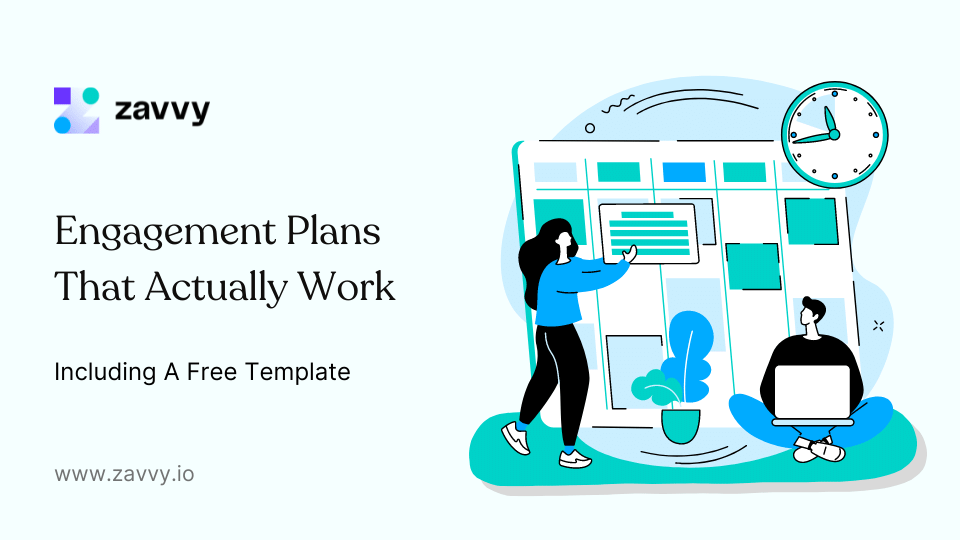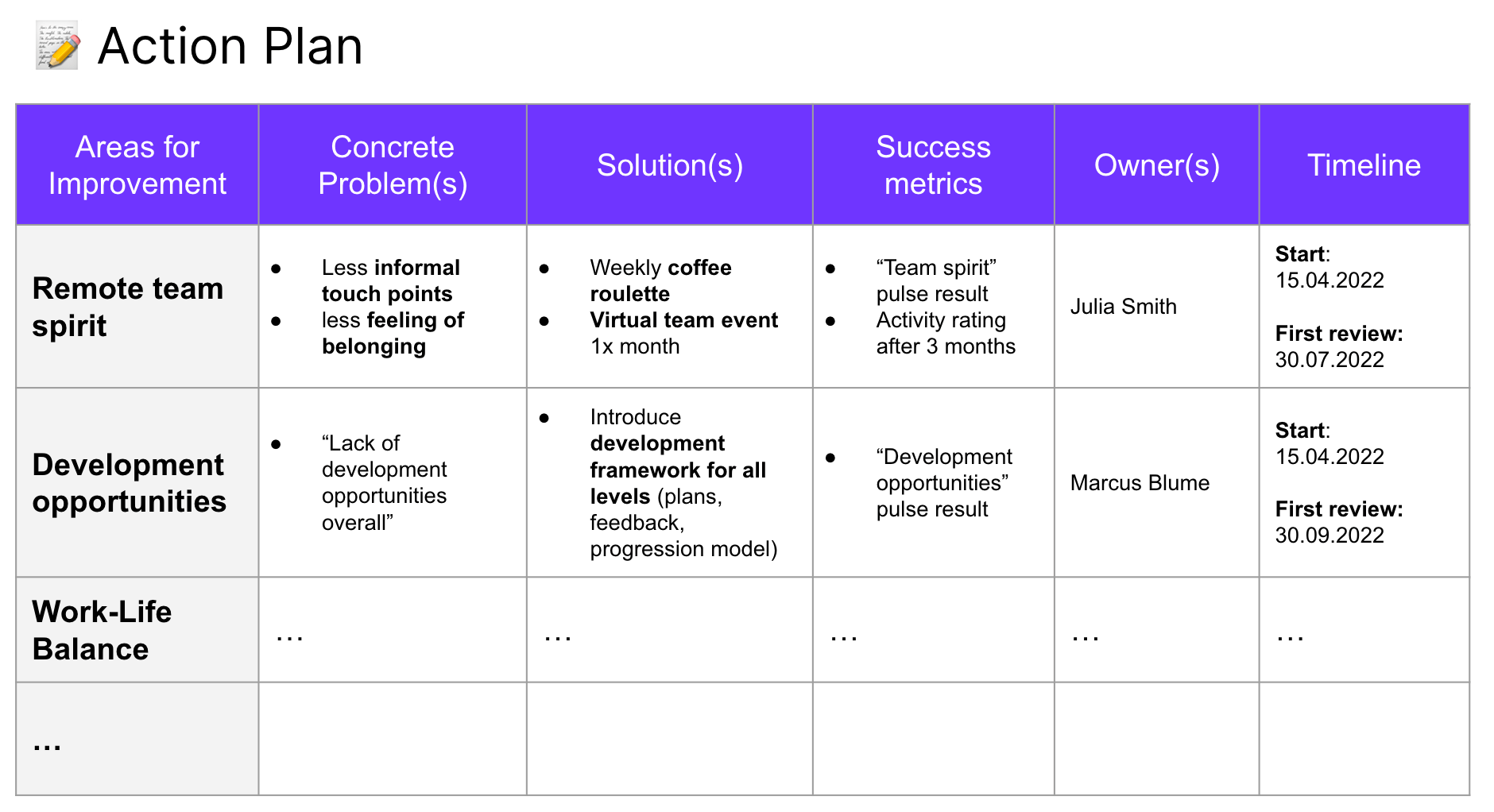
Alexander Heinle
Alex is a marketer at Zavvy. On this blog, he mainly shares insights gained from discussions with selected experts and from helping our customers set up and improve their onboarding or learning programs.


Are your employees engaged at work?
If you scratched your head and couldn't come up with a resounding "Yes!" it may be time to build or revise your employee engagement plan.
Engaging your employees is an important business strategy. After all, engaged employees are highly invested in their jobs, care about the success of their teams, and happily contribute to a company's growth.
According to Gallup, engaged employees are more productive, focused on their goals, overcome obstacles, and perform with excellence. Yet, surprisingly, only 40% of organizations have an employee engagement program.
A workplace isn't made up of office premises, unique decor pieces, fancy furniture, luxurious facilities, or equipment.
The people make up an organization and determine the organization's quality and its future. This is why many corporate leaders have come to realize that engaging employees goes beyond talent acquisition and recruitment.
Today's employees want to work with companies that understand and implement policies throughout the entire employee cycle.
Employee engagement isn't some fairy dust, but it sure brings some magic and happiness to your organization. And not only does it happen in great, people-centric organizations, but it can also create greater organizations.
So, why is creating an employee engagement plan important?
Read on for a thorough guide and downloadable template you can customize to fit your organization's needs.
Together with our curators, we have created a library of actionable digital marketing resources. Personalized to your team's needs.
"Employees who believe that management is concerned about them as a whole person – not just an employee – are more productive, more satisfied, more fulfilled. Satisfied employees mean satisfied customers, which leads to profitability."
- Anne Mulcahy
This quote from the former CEO of Xerox is a great reminder that while employees spend most of their time at work, it is essential to see them beyond their working hours.
They are humans first, before becoming employees.
Employees flourish when corporate leadership recognizes them as human and acknowledges all the influences in their lives. Not just what happens at work.
A 2017 Gallup study discovered that only 15% of the world's one billion full-time employees were truly engaged at work.
Alarming, right?
Lower employee engagement means
all of which can reduce a company's profit margin.
It's a downturn that stems from the inability to truly manage human capital, or more specifically, the inability to grasp employee engagement fully.
This begs the question, "what is employee engagement?"
Employee engagement measures the level of dedication and enthusiasm an employee has towards achieving company success.
A truly engaged employee doesn't just go through the motions of work and count down the time to receive their paychecks.
Instead, they care about their jobs and focus on making a meaningful contribution to the organization they work for, thanks to the outstanding employee engagement experiences the company provides in return.
A Zenefits research showed that 63.3% of companies found it easier to hire their employees than retain them.
While employee engagement is important, this statistic shows that achieving a high employee engagement rate is no easy feat.
This is where an employee engagement action plan enters the equation.
An employee engagement action plan comprehensively explains or outlines the strategies for keeping your employees fully engaged.
An employee engagement plan identifies the major factors that influence employee engagement by uncovering employees' pain points and creating personalized initiatives to address them.
Depending on the employees' identified pain points, these initiatives can be quick and easy changes or long-term ones.
Your employee engagement plan should provide an outline of the following:
Examples for goals and actions could be
According to Gallup, simply measuring employees' satisfaction doesn't improve business outcomes. Instead, approaching employee engagement as a business strategy yields better organic results.

Organizations should create an employee engagement plan to…
According to Gallup's State of the American Workforce Report 2017, engaged employees are more likely to consistently show up to work and commit to providing the best customer experience.
This same report also emphasized that engaged teams have
"Talent branding is the fulfillment of a promise of the employee experience. It is informed with every interaction by employees in the organization, from pre-employment vetting to post-employment separations. It is the dialogue of that experience, owned by every past, present, or potential employee, and visible everywhere."
- Jody Ordioni (culled from Jody's book: The Talent Brand)
Employees are a business's first customers. Therefore, an organization needs to treat its employees well and make them feel valued, as would be done to customers.
When this doesn't happen, The Engagement Institute reports that disengaged employees cost organizations an estimated $450 billion to $550 billion every year in the United States. The report also noted that about 95% of workers claimed to know when they're becoming disengaged.
Therefore, now more than ever, organizations must provide and maintain a positive employee experience to increase employee retention rate and lower turnover, enhance employee motivation and happiness, and ultimately increase the company's revenue.
86% of employees and job seekers research company reviews and ratings to decide where to apply for a job.
68% of Millennials, 54% of Gen-Xers, and 48% of Baby Boomers acknowledged visiting a potential employer's social media channels specifically to assess their employer brand.

These statistics show that positive employer branding can make you stand out from the sea of competitors.
It is why companies like HubSpot, Google, and Salesforce "do not pick talents, as talents pick them." Creating a unique employee engagement plan is the first step toward building a strong employer brand and enjoying benefits such as attracting top talents, streamlining the hiring process, and reducing recruitment costs.
Your employee engagement plan contributes to strengthening relationships with employees by publicly recognizing them for their contributions to the company's success.
An Achievers Solutions Inc. 2020 Engagement and Retention report showed that approximately 92% of employees claimed to repeat specific tasks in the future when they're recognized for it.
Recognition makes employees feel valued and motivates them to give their all.

Keeping employees engaged means making them feel valued as a member of the company and as part of a community. The more your employees feel engaged, the more they will go the extra mile in their jobs.
➡️ Take the shortcut and build your own engagement action plan with our template.

Why should you identify your company's employer value proposition?
The war for talent is increasingly fierce, and today's candidates won't settle for less. Identifying your EVP helps sharpen your company's identity and culture, bolster your employer brand ratings, and improve your recruitment process.
Your EVP should strike the perfect balance between attractive and realistic to attract top talents.
While buzzwords might sound pleasing to your ears, today's candidates want simple and easy-to-understand words that clearly communicate what you want from them (via job ads) and what they stand to gain in return.
Your EVP should contain:
Since engaged employees are known to feel closely connected to an organization's values, mission, vision, etc., it only makes sense to create an EVP that your employees can passionately explain even in their sleep.
"If you define the problem correctly, you almost have the solution."
- Steve Jobs
Constructing a house doesn't begin from the roof — you start by building the foundation at the bottom.
The same principle applies to writing your employee engagement plan: You use surveys to ask employees about the company's weaknesses, strengths, and areas of improvement.
Armed with this feedback, analyze the data to determine what drives employee engagement (or lack thereof) and what can be done to boost employee engagement.
A good rule of thumb is to consider the following variables as they're known to influence employee engagement rates highly:
Tips:
Review the data and identify the areas of improvement. Arrange the solutions according to the order of importance and identify two to three focus points. Consider the following:
You've identified your employees' pain points and recognized areas of improvement. Now is the time to breathe life into them. Alongside your team, discuss the feedback from the data and build focus groups for each of the themes identified.
Brainstorm ways to improve each focus area by creating a list of as many ideas as possible, and then prune it down to the ones your team prefers. For example,
The success of your employee engagement plan largely depends on how well all of your employees understand it.
This is your chance to make them feel heard.
Imagine the irony of an unclear plan alienating colleagues and ultimately even lowering engagement.
The following components should be part of your transparent communication:
S.M.A.R.T. goals help concretize your goals and be more accountable in the long run.
Zig Ziglar once said,
"A goal properly set is halfway reached."
And if your goals aren't SMART, well, they're superficial.
Think of goal setting as a compass that guides your company to achieve its goals and steers it in the right direction, should it (want to) veer off the course.
Keep in mind that the goals you set must be
In other words, SMART.

Without identifying areas to measure and improve upon, it's almost impossible to create a great employee engagement plan, much less implement strategic employee engagement-related programs.
Rather than focusing on all facets of employee engagement, identify the critical variables of employee engagement (in your company), and decide which ones can be easily and quickly tackled with existing resources.
Resource planning can either make or break a good employee engagement plan.
Once your goals are in place, preparing your action plan is the next step.
You'll want to allocate resources and define your KPIs to measure progress at this stage. Remember that your action plan's success rests on the buy-in of your employees' direct supervisors.
Employee engagement rates are known to increase when managers fully understand the role and purpose of your employee engagement plan.
It enables them to effectively distribute positive results across all departments and even propose future initiatives that can be incorporated.
A good employee engagement action plan should also contain strategies for sustaining engagement rates within the company as it continues to scale. Strategies for ensuring sustainable development include:
Pro Tip: An effective employee engagement plan results don't come in after a day. It takes consistency to achieve remarkable results.
No one likes employee disengagement or dissatisfaction. It's bad for business.
And while achieving 100% employee engagement in an organization seems impossible, it actually isn't — if you're ready to put in the work and listen to your employees.
Employee enablement is our approach to following survey results with actual measures.
If you're interested in learning how Zavvy can help you improve employee engagement and enable your employees to be the best version of themselves, click here for a demo.
Upskill your team every week with the best contents and personalized recommendations.

Are your employees engaged at work?
If you scratched your head and couldn't come up with a resounding "Yes!" it may be time to build or revise your employee engagement plan.
Engaging your employees is an important business strategy. After all, engaged employees are highly invested in their jobs, care about the success of their teams, and happily contribute to a company's growth.
According to Gallup, engaged employees are more productive, focused on their goals, overcome obstacles, and perform with excellence. Yet, surprisingly, only 40% of organizations have an employee engagement program.
A workplace isn't made up of office premises, unique decor pieces, fancy furniture, luxurious facilities, or equipment.
The people make up an organization and determine the organization's quality and its future. This is why many corporate leaders have come to realize that engaging employees goes beyond talent acquisition and recruitment.
Today's employees want to work with companies that understand and implement policies throughout the entire employee cycle.
Employee engagement isn't some fairy dust, but it sure brings some magic and happiness to your organization. And not only does it happen in great, people-centric organizations, but it can also create greater organizations.
So, why is creating an employee engagement plan important?
Read on for a thorough guide and downloadable template you can customize to fit your organization's needs.
Get a demo!
We'll be happy to show you around and answer all your questions.
Trusted by innovative companies



We'll be happy to show you around, answer your questions, or arrange a free trial.
Erhalten Sie eine kostenlose Demo unserer Onboarding-Software.
Vertraut von



Your Training & Development Strategy - Solved in 1 Tool.
Trusted by innovative companies



We'll be happy to show you around, answer your questions, or arrange a free trial.
Learn how Zavvy helps you drive performance, development, and engagement.
Trusted by innovative companies



We'll be happy to show you around, answer your questions, or arrange a free trial.
We'll be happy to show you around and answer all your questions.
Trusted by innovative companies



We'll be happy to show you around, answer your questions, or arrange a free trial.
Gerne zeigen wir Ihnen ganz unverbindlich unsere Plattform im Detail.
Vertraut von modernen Unternehmen



Get a demo!
We'll be happy to show you around and answer all your questions.
Trusted by innovative companies



We'll be happy to show you around, answer your questions, or arrange a free trial.
Erhalten Sie eine kostenlose Demo unserer Software für Mitarbeiterenwicklung und Training.
Moderne Unternehmen
setzen auf Zavvy


